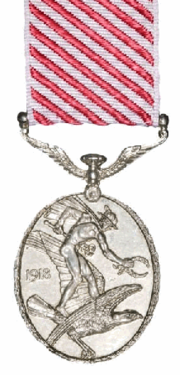History
The medal was established on 3 June 1918. It was the other ranks' equivalent to the Air Force Cross (AFC), which was awarded to commissioned officers and Warrant Officers, although the latter could also be awarded the AFC. It ranked below the AFC in order of precedence, between the Distinguished Flying Medal and the Queen's Gallantry Medal. [2]
Although the new award was announced in the London Gazette on 3 June 1918, [5] the actual Royal Warrants were not published in the London Gazette until 5 December 1919. [6]
A bar, worn on the ribbon, could be awarded to recognise a second award of the Air Force Medal. [4]
Recipients are entitled to use the post-nominal letters "AFM". [7]
The first two awards appeared in the London Gazette on 3 June 1918, to: [8]
- 11680 Serjeant Samuel James Mitchell (of Handsworth, Birmingham).
- 106100 Serjeant Frederick Charles Tucker (of Birtley, Durham).
Twenty-nine awards appeared in a supplement to the London Gazette of 8 February 1919. [9] [10]
The first awards of a bar to the Air Force Medal were announced on 26 December 1919, to two sergeants in the Australian Flying Corps, for providing support to a pioneering flight from London to Australia: [11]
- 275 Sergeant James Mallett Bennett, A.F.M. [12]
- 8974 Sergeant Walter Henry Shiers, A.F.M. [13]
In 1979 eligibility for a number of British awards, including the AFM, was extended to permit posthumous awards. [14] Until that time, only the Victoria Cross and a mention in dispatches could be awarded posthumously.
In 1993, the AFM was discontinued, as part of the review of the British honours system, which recommended removing distinctions of rank in respect of awards for bravery. Since then, the Air Force Cross, previously only open to Commissioned and Warrant Officers, has been awarded to personnel of all ranks. [4]
The AFM had also been awarded by Commonwealth countries but by the 1990s most, including Canada, Australia and New Zealand, had established their own honours systems and no longer recommended British honours. [15]
This page is based on this
Wikipedia article Text is available under the
CC BY-SA 4.0 license; additional terms may apply.
Images, videos and audio are available under their respective licenses.








